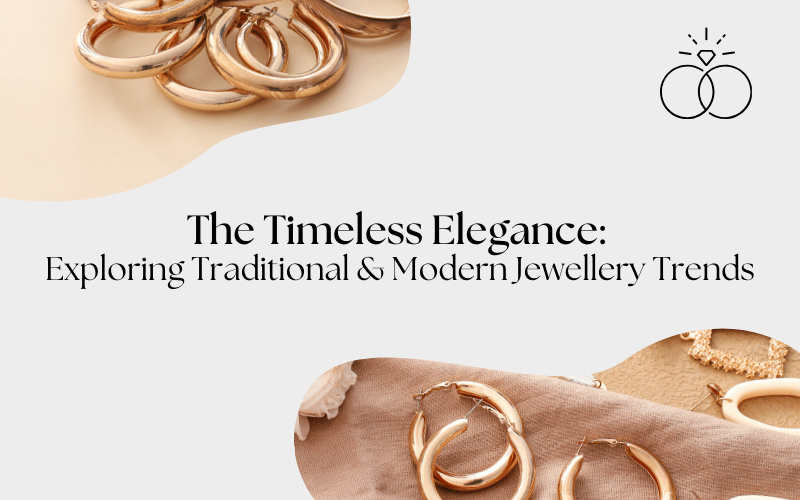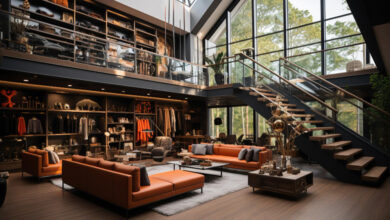The Timeless Elegance: Exploring Traditional and Modern Jewelry Trends

The Timeless Elegance: Exploring Traditional and Modern Jewellery Trends
Jewellery, in its myriad forms, encapsulates more than mere adornment; it embodies an expression of culture, an indicator of trends, and a marker of personal identity. Timeless elegance in jewellery is a concept that bridges the gap between the past and the present, intertwining traditional craftsmanship with modern innovation. In today’s fashion landscape, both traditional and modern designs play pivotal roles, each influencing and enriching the other.
This blog seeks to delve into the evolution of jewellery trends, exploring how certain styles have stood the test of time while others have emerged to meet new tastes and technologies. By tracing the lineage of these designs and understanding their enduring appeal, we can appreciate the depth and diversity of jewellery not just as fashion items, but as historical and cultural artifacts.
The Allure of Traditional Jewellery
Historical Significance
Traditional jewellery often carries rich historical significance, serving as a repository of cultural heritage. For example, in India, jewellery like the Kundan and Meenakari pieces reflect the craftsmanship that flourished under royal patronage. Similarly, Native American turquoise jewellery or the Celtic designs of Europe tell stories of their respective societies through motifs and materials used.
Iconic Designs
Timeless pieces such as solitaire rings, pearl necklaces, and intricate gold bangles have adorned humans for centuries. Each piece holds a tale of its era, from the solitaire’s prominence in engagements to the pearl necklace’s symbol of sophistication and class. These items are not only beautiful but also deeply symbolic, representing status, commitment, or even rites of passage.
Craftsmanship and Materials
The traditional jewellery-making process is a testament to the artisanal skills passed down through generations. Techniques such as filigree, chasing, and repoussé involve meticulous handwork that machines cannot replicate. Materials like gold, silver, and precious stones have been favored for their durability and intrinsic value, making them staples in traditional designs.
Traditional Jewellery Trends
Traditional jewellery often reflects centuries-old craftsmanship and designs that are deeply rooted in a culture’s heritage. These pieces are typically made with precious metals like gold and silver and are often embellished with gemstones like diamonds, rubies, and emeralds. Common traditional styles include:
- Classic Gold Designs: From elaborate gold necklaces in Indian bridal wear to intricate Italian gold filigree earrings, these pieces are cherished for their craftsmanship and longevity.
- Cultural Symbols: Celtic knots, Egyptian scarabs, and Native American turquoise bracelets serve not only as adornments but also as symbols of cultural identity.
- Heirloom Pieces: jewellery passed down through generations, often customized or updated slightly to maintain its historical essence while keeping it wearable for modern times.
The Rise of Modern Jewellery Trends
Innovation in Design
Modern jewellery redefines boundaries with its bold and unconventional designs. Utilizing cutting-edge technology like 3D printing, designers create intricate and unusual shapes that were once impossible. Materials such as titanium, recycled metals, and even synthetic gemstones feature prominently, reflecting a shift towards innovation and sustainability.
Influential Designers and Brands
Designers like Iris Van Herpen and brands like Swarovski are at the forefront of modern jewellery trends. They blend technology with art to produce pieces that are both avant-garde and wearable. Their work influences not only the aesthetics of jewellery but also its production methods and the way it is worn.
Sustainability and Ethical Practices
Today’s jewellery is increasingly characterized by its ethical and sustainable production. Brands are prioritizing transparency, sourcing conflict-free diamonds, and using recycled materials to reduce their ecological footprint. This shift not only appeals to eco-conscious consumers but also sets a new standard for the industry, promoting practices that respect both people and the planet.
Modern Jewellery Trends
Modern jewellery is characterized by its innovation and the use of unconventional materials and designs. It often mirrors current fashion trends and technological advancements:
- Minimalist Designs: Sleek, geometric shapes and a clean aesthetic dominate modern jewellery, reflecting a contemporary preference for simplicity and minimalism.
- Eco-Friendly Materials: The use of recycled metals, ethically sourced gemstones, and even alternative materials like wood and fabric reflects a growing environmental awareness.
- Technological Incorporations: Incorporating technology, modern jewellery includes wearable tech pieces like smart rings and bracelets that track health metrics or offer connectivity features.
Comparing Traditional and Modern jewellery
Aesthetic and Functional Differences
- Visual Style: Traditional jewellery often features intricate patterns and a rich use of color, making it visually striking and elaborate. Modern jewellery, by contrast, tends to embrace simpler, cleaner lines with a focus on unconventional forms and structures.
- Functionality: While traditional pieces are often designed for special occasions and durability, modern jewellery might incorporate elements that cater to practicality and comfort, suitable for everyday wear.
Occasions and Wearability
- Formal Events: Traditional jewellery remains a popular choice for weddings, religious ceremonies, and other formal occasions where its elegance and symbolic value shine. For example, a classic pearl necklace or a diamond tiara can complete a bridal look.
- Casual Outings: Modern jewellery is often preferred for casual settings due to its simplicity and versatility. Pieces like a minimalist silver bangle or a stylish statement ring can enhance everyday outfits without overpowering them.
Consumer Preferences
- Age Groups: Younger consumers, particularly millennials and Gen Z, are drawn to modern designs that align with their values of sustainability and individual expression. Meanwhile, older generations might prefer traditional jewellery for its craftsmanship and the emotional connections it evokes.
- Cultural Influences: Cultural background plays a significant role in jewellery preference. In many Eastern cultures, traditional jewellery is integral to cultural celebrations and is often considered an investment. Conversely, in Western cultures, there’s a significant lean towards modern designs that reflect current fashion trends.
The Fusion of Old and New
Hybrid Styles
In the world of jewellery, the lines between old and new are beautifully blurred by designers who are pioneering hybrid styles. These innovative pieces merge traditional elements with modern aesthetics, crafting a bridge between generations of fashion. For instance, some gold jewellers in Kolkata are skillfully incorporating classic motifs from Bengali heritage, such as intricate filigree work, into sleek, contemporary designs. This approach not only honors traditional craftsmanship but also appeals to the modern consumer’s taste for unique and personalized jewellery.
Popularity and Market Trends
The jewellery market is constantly evolving, reflecting changes in consumer preferences and broader fashion trends. Currently, there’s a notable resurgence in the popularity of vintage and retro styles, particularly among younger consumers who value the uniqueness and story behind each piece. Conversely, there’s been a slight decline in the demand for overly ornate traditional jewellery, as today’s buyers often seek versatility and comfort suitable for daily wear. This shift is prompting designers to create pieces that maintain a timeless appeal without sacrificing modern practicality.
Conclusion
Looking ahead, the future of jewellery design seems poised to further embrace the fusion of traditional and modern elements. As technology advances, we may see even more innovative materials and techniques being used, while the appreciation for handcrafted, artisanal pieces remains strong. The integration of digital tools and augmented reality in jewellery shopping could also revolutionize how consumers select and personalize their pieces, offering a blend of convenience and customization.
As a passionate observer of jewellery trends, I believe that preserving traditional designs while incorporating modern innovations is crucial. This balance not only keeps our cultural heritage alive but also enriches it, making it relevant for new generations. Jewellery is more than just adornment; it’s a form of expression, a piece of art that tells a story. By supporting both traditional and modern designs, we keep these stories alive and evolving.





